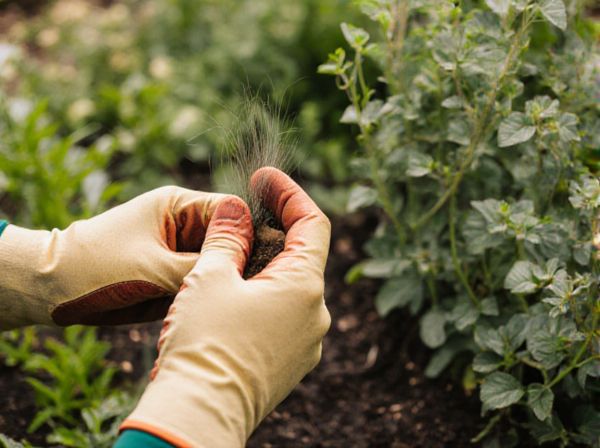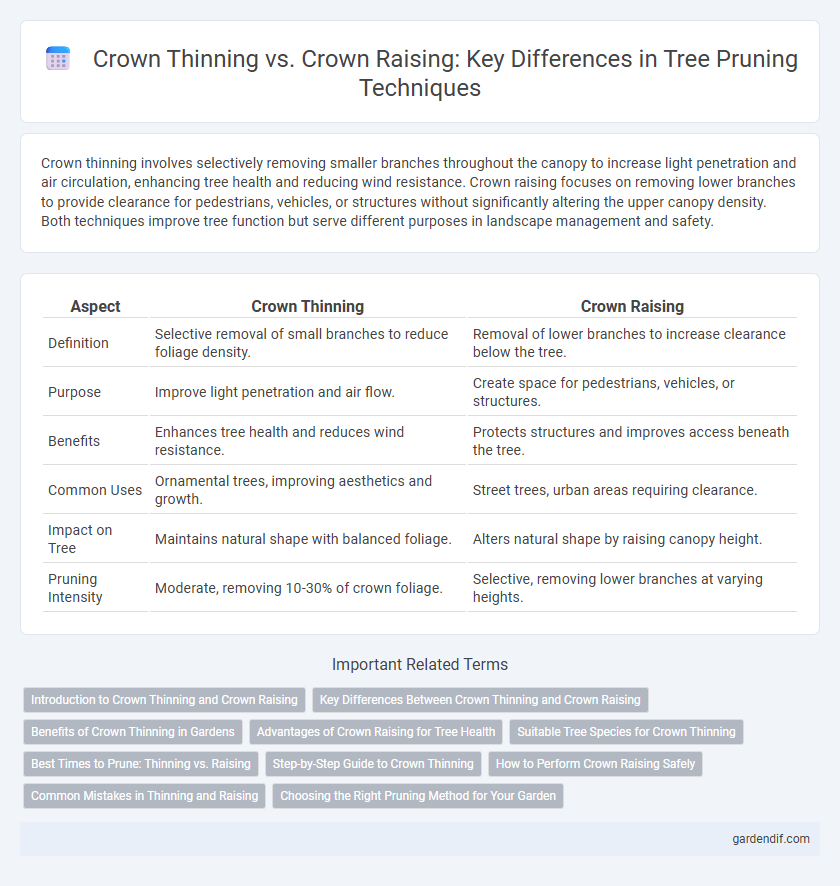
Crown thinning vs crown raising Illustration
Crown thinning involves selectively removing smaller branches throughout the canopy to increase light penetration and air circulation, enhancing tree health and reducing wind resistance. Crown raising focuses on removing lower branches to provide clearance for pedestrians, vehicles, or structures without significantly altering the upper canopy density. Both techniques improve tree function but serve different purposes in landscape management and safety.
Table of Comparison
| Aspect | Crown Thinning | Crown Raising |
|---|---|---|
| Definition | Selective removal of small branches to reduce foliage density. | Removal of lower branches to increase clearance below the tree. |
| Purpose | Improve light penetration and air flow. | Create space for pedestrians, vehicles, or structures. |
| Benefits | Enhances tree health and reduces wind resistance. | Protects structures and improves access beneath the tree. |
| Common Uses | Ornamental trees, improving aesthetics and growth. | Street trees, urban areas requiring clearance. |
| Impact on Tree | Maintains natural shape with balanced foliage. | Alters natural shape by raising canopy height. |
| Pruning Intensity | Moderate, removing 10-30% of crown foliage. | Selective, removing lower branches at varying heights. |
Introduction to Crown Thinning and Crown Raising
Crown thinning involves selectively removing branches within the tree's canopy to increase light penetration and air circulation, enhancing overall tree health and reducing wind resistance. Crown raising entails removing the lower branches to provide clearance for pedestrians, vehicles, or structures, improving access and visibility without compromising the tree's structural integrity. Both techniques play crucial roles in urban forestry management and landscape maintenance, tailored to specific functional requirements and tree species.
Key Differences Between Crown Thinning and Crown Raising
Crown thinning involves selectively removing branches within the tree's canopy to increase light penetration and air circulation, enhancing the tree's overall health and reducing wind resistance. Crown raising focuses on removing the lower branches to elevate the canopy, improving clearance for pedestrians, vehicles, or structures beneath the tree. The key difference lies in crown thinning targeting internal branch density, while crown raising targets the vertical clearance of the crown.
Benefits of Crown Thinning in Gardens
Crown thinning enhances light penetration and air circulation within the tree canopy, promoting healthier growth and reducing the risk of fungal diseases in gardens. By selectively removing smaller branches, it decreases wind resistance and potential storm damage while preserving the tree's natural shape. This targeted pruning method supports overall garden aesthetics and improves the vitality of surrounding plants.
Advantages of Crown Raising for Tree Health
Crown raising improves tree health by enhancing light penetration and air circulation within the tree canopy, reducing the risk of fungal diseases and promoting vigorous growth. It minimizes mechanical damage by increasing clearance between lower branches and ground-level activities, preventing injury or obstruction. This pruning practice also supports structural stability by redistributing weight more evenly along the main stem.
Suitable Tree Species for Crown Thinning
Crown thinning is particularly suitable for species with dense foliage such as maples, oaks, and elms, as it improves light penetration and air circulation without significantly altering the natural shape. These trees benefit from selective removal of smaller branches, reducing wind resistance and minimizing storm damage risks. In contrast, crown raising targets lower branches and is more appropriate for trees like pines and firs where clearing the lower canopy enhances clearance and visibility.
Best Times to Prune: Thinning vs. Raising
Pruning crown thinning is best performed during the dormant season or early spring to minimize stress and promote healthy growth, allowing light and air to penetrate the canopy. Crown raising should be done in late winter or early spring before new growth starts to maintain structural integrity and avoid excessive sap loss. Choosing the optimal timing for each technique improves tree health and enhances the aesthetic and functional benefits of the pruning.
Step-by-Step Guide to Crown Thinning
Crown thinning involves selectively removing branches throughout the tree's crown to increase light penetration and air flow, enhancing tree health and reducing wind resistance. Start by identifying and removing crossing, rubbing, or dead branches, then thin out smaller branches to maintain the natural shape while avoiding over-thinning, which can stress the tree. Use pruning tools like hand shears or loppers to make clean cuts at branch junctions, promoting faster healing and minimizing disease risk.
How to Perform Crown Raising Safely
To perform crown raising safely, begin by removing lower branches gradually, maintaining balanced branch distribution to prevent tree instability. Use clean, sharp pruning tools to make precise cuts just outside the branch collar, minimizing damage and promoting healthy healing. Always assess the tree's overall structure and avoid removing more than one-quarter of the live crown to ensure long-term vigor and safety.
Common Mistakes in Thinning and Raising
Common mistakes in crown thinning include removing too many inner branches, which reduces the tree's natural shape and weakens structural integrity. In crown raising, improper cuts too close to the trunk or leaving large stubs can cause decay and poor wound healing. Both techniques require precision to maintain tree health and avoid long-term damage.
Choosing the Right Pruning Method for Your Garden
Choosing the right pruning method depends on your garden's needs and tree health. Crown thinning improves air circulation and light penetration by selectively removing smaller branches, promoting overall growth, while crown raising involves removing lower branches to increase clearance and visibility. Assess tree species, size, and desired outcomes to determine whether crown thinning or crown raising best supports your garden's aesthetics and safety.
Crown thinning vs crown raising Infographic

 gardendif.com
gardendif.com